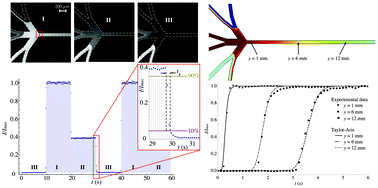Controlled microfluidic switching in arbitrary time-sequences with low drag†
Abstract
The ability to test the response of cells and

- This article is part of the themed collection: Celebrating the 2016 RSC Prize and Award Winners
* Corresponding authors
a
Nanometer Structure Consortium (nmC@LU) and Division of Solid State Physics, Lund University, Box 118, 221 00 Lund, Sweden
E-mail:
cassandra.niman@ftf.lth.se, heiner.linke@ftf.lth.se
Tel: +46 46 222 4495
b School of Physics, University of New South Wales, Sydney, New South Wales 2052, Australia
c Centre of Applied Medical Research, St. Vincent's Hospital, Darlinghurst, New South Wales 2010, Australia
d School of Chemistry, University of Bristol, Cantock's Close, Bristol BS8 1TS, UK
e School of Biochemistry, University of Bristol, Medical Sciences Building, University Walk, Bristol BS8 1TD, UK
f Department of Physics, Simon Fraser University, Burnaby, British Columbia V5A 1S6, Canada
The ability to test the response of cells and

 Please wait while we load your content...
Something went wrong. Try again?
Please wait while we load your content...
Something went wrong. Try again?
C. S. Niman, J. P. Beech, J. O. Tegenfeldt, P. M. G. Curmi, D. N. Woolfson, N. R. Forde and H. Linke, Lab Chip, 2013, 13, 2389 DOI: 10.1039/C3LC50194A
To request permission to reproduce material from this article, please go to the Copyright Clearance Center request page.
If you are an author contributing to an RSC publication, you do not need to request permission provided correct acknowledgement is given.
If you are the author of this article, you do not need to request permission to reproduce figures and diagrams provided correct acknowledgement is given. If you want to reproduce the whole article in a third-party publication (excluding your thesis/dissertation for which permission is not required) please go to the Copyright Clearance Center request page.
Read more about how to correctly acknowledge RSC content.
 Fetching data from CrossRef.
Fetching data from CrossRef.
This may take some time to load.
Loading related content
